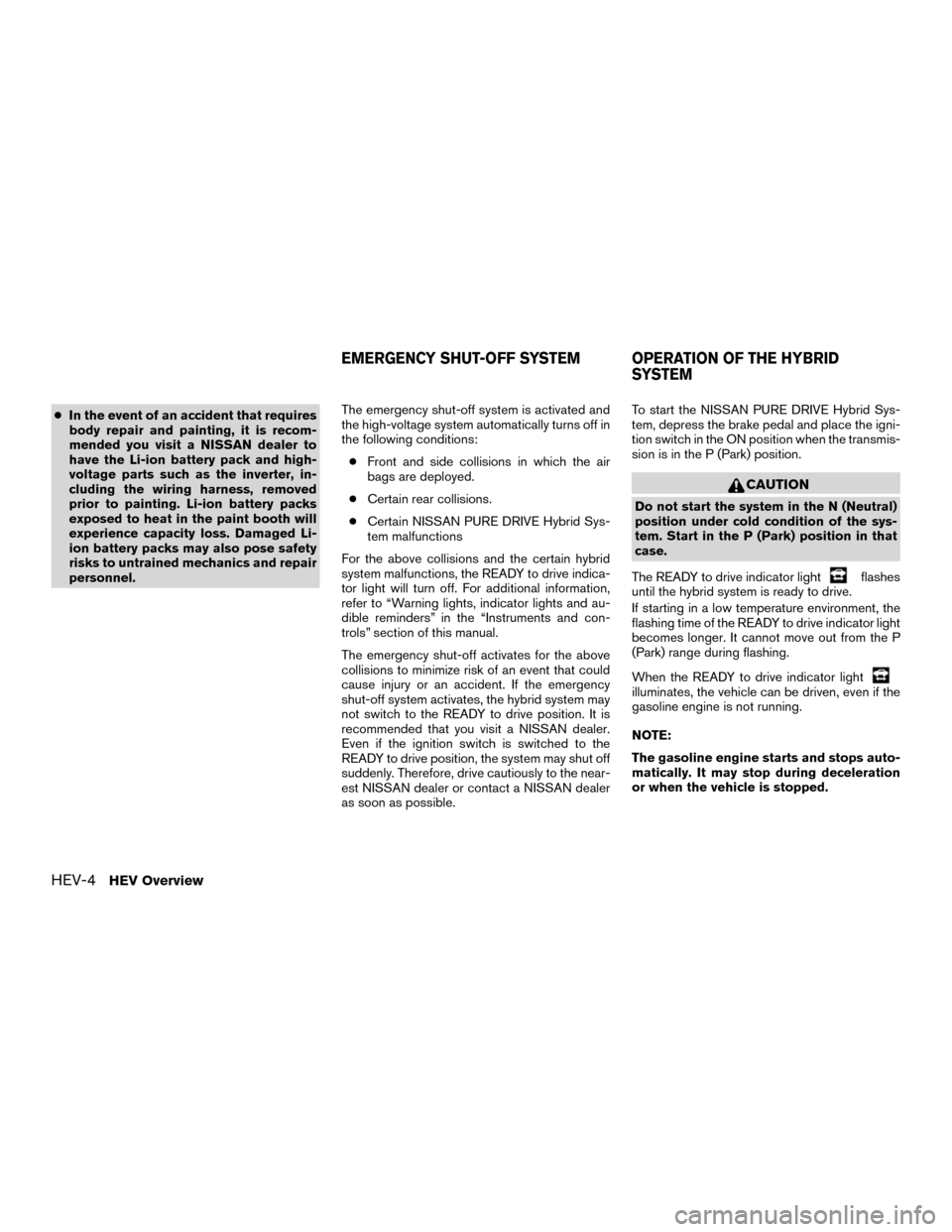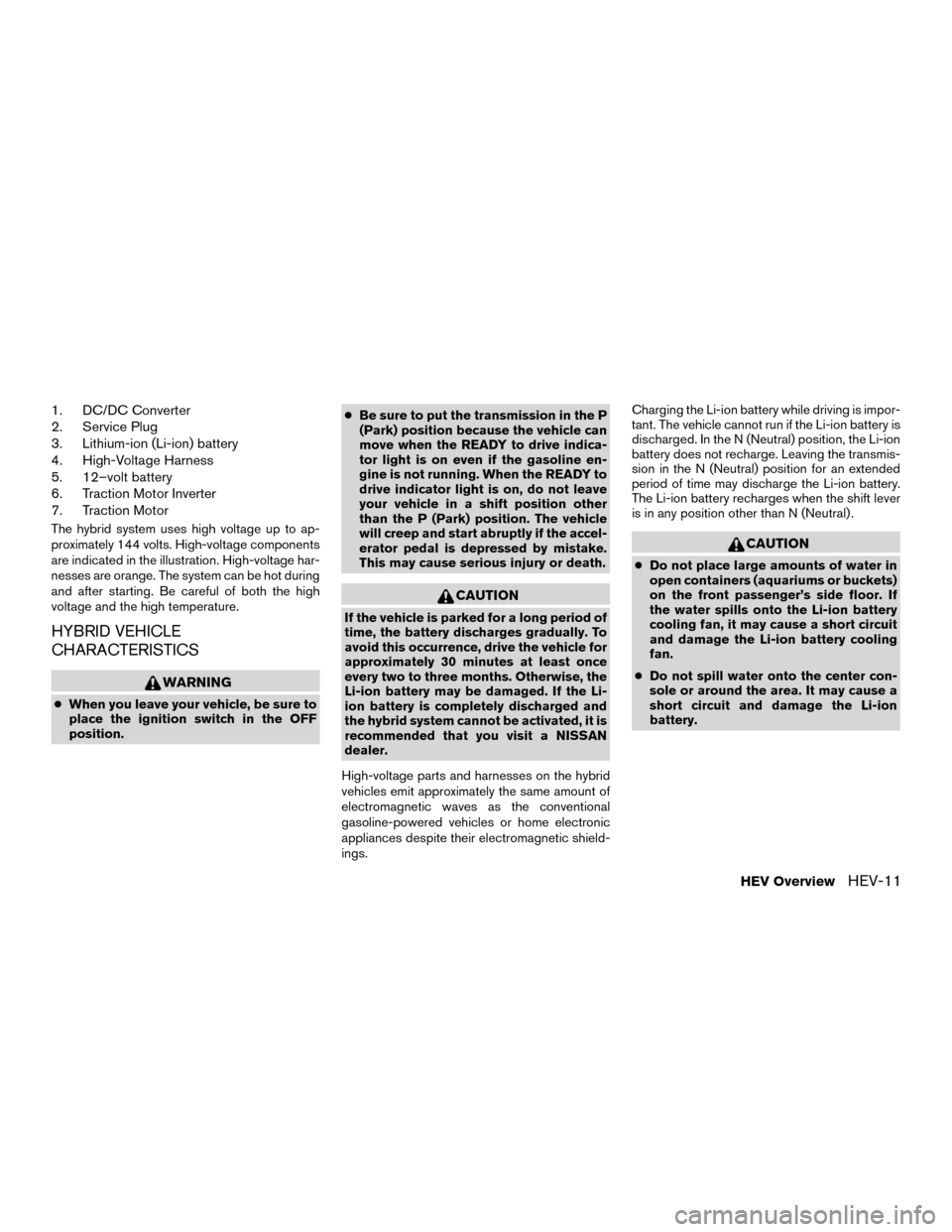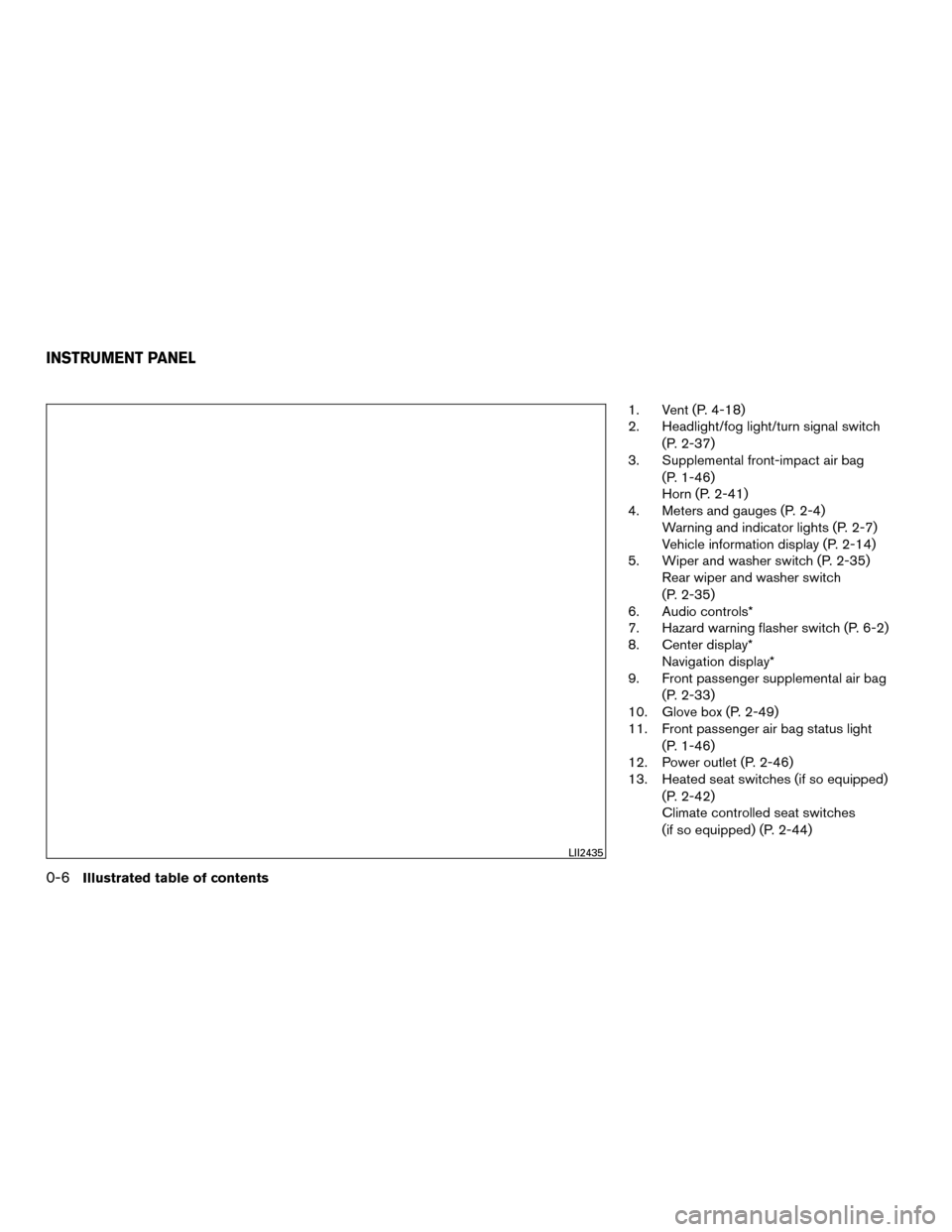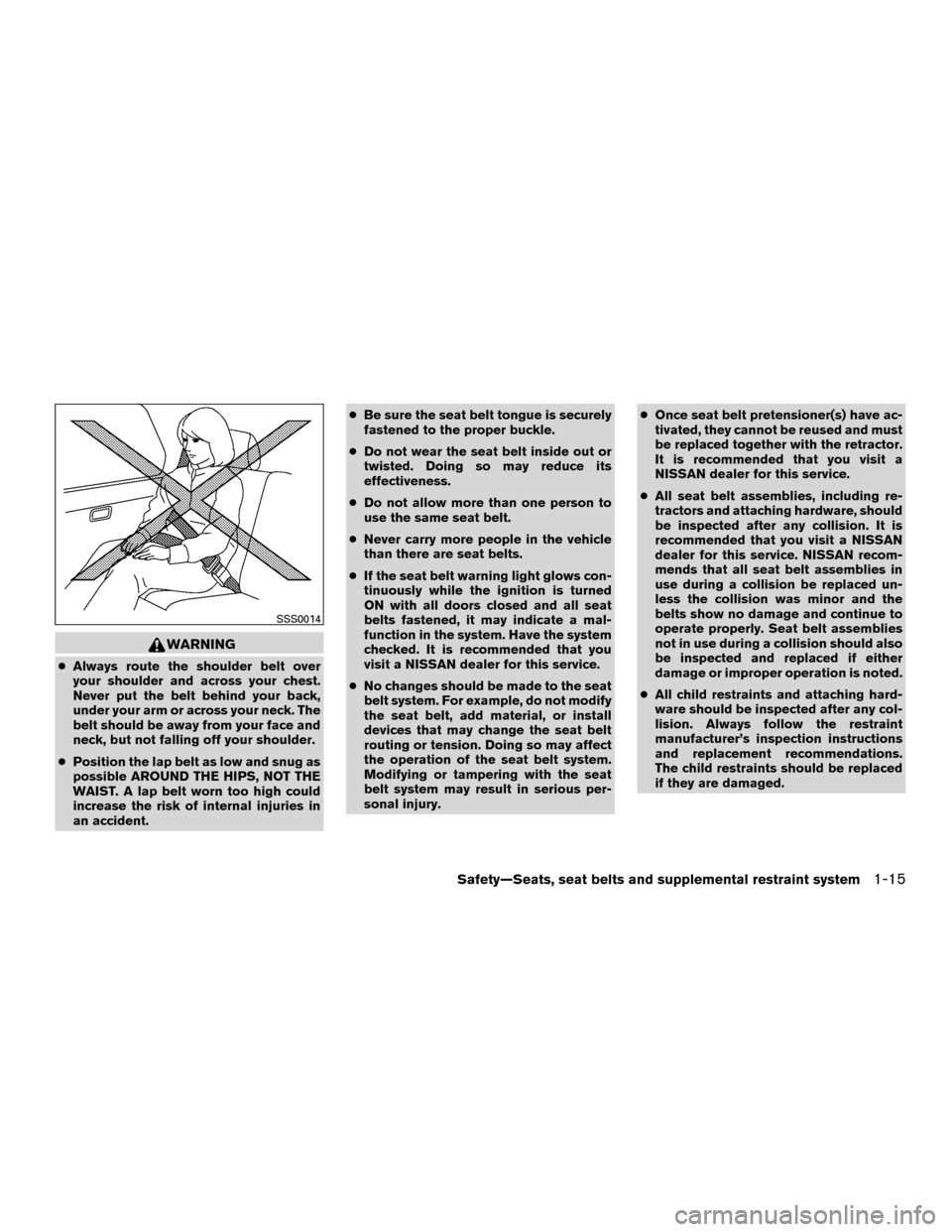2016 NISSAN MURANO HYBRID warning light
[x] Cancel search: warning lightPage 11 of 443

●In the event of an accident that requires
body repair and painting, it is recom-
mended you visit a NISSAN dealer to
have the Li-ion battery pack and high-
voltage parts such as the inverter, in-
cluding the wiring harness, removed
prior to painting. Li-ion battery packs
exposed to heat in the paint booth will
experience capacity loss. Damaged Li-
ion battery packs may also pose safety
risks to untrained mechanics and repair
personnel. The emergency shut-off system is activated and
the high-voltage system automatically turns off in
the following conditions:
● Front and side collisions in which the air
bags are deployed.
● Certain rear collisions.
● Certain NISSAN PURE DRIVE Hybrid Sys-
tem malfunctions
For the above collisions and the certain hybrid
system malfunctions, the READY to drive indica-
tor light will turn off. For additional information,
refer to “Warning lights, indicator lights and au-
dible reminders” in the “Instruments and con-
trols” section of this manual.
The emergency shut-off activates for the above
collisions to minimize risk of an event that could
cause injury or an accident. If the emergency
shut-off system activates, the hybrid system may
not switch to the READY to drive position. It is
recommended that you visit a NISSAN dealer.
Even if the ignition switch is switched to the
READY to drive position, the system may shut off
suddenly. Therefore, drive cautiously to the near-
est NISSAN dealer or contact a NISSAN dealer
as soon as possible. To start the NISSAN PURE DRIVE Hybrid Sys-
tem, depress the brake pedal and place the igni-
tion switch in the ON position when the transmis-
sion is in the P (Park) position.
CAUTION
Do not start the system in the N (Neutral)
position under cold condition of the sys-
tem. Start in the P (Park) position in that
case.
The READY to drive indicator light
flashes
until the hybrid system is ready to drive.
If starting in a low temperature environment, the
flashing time of the READY to drive indicator light
becomes longer. It cannot move out from the P
(Park) range during flashing.
When the READY to drive indicator light
illuminates, the vehicle can be driven, even if the
gasoline engine is not running.
NOTE:
The gasoline engine starts and stops auto-
matically. It may stop during deceleration
or when the vehicle is stopped.
EMERGENCY SHUT-OFF SYSTEM OPERATION OF THE HYBRID SYSTEM
HEV-4HEV Overview
Page 16 of 443

Drive your vehicle with smooth accelera-
tion and deceleration.● While driving, energy is recovered through
the regenerative brake as the vehicle decel-
erates. However, for most efficient use, do
not accelerate or decelerate your vehicle
more than necessary.
● Avoid abrupt acceleration and deceleration.
● The power of the Li-ion battery can be
checked on the Energy Flow in the center
display or Li-ion battery status meter in the
vehicle information display. For additional
information, refer to “Energy Flow” in this
section or “Vehicle information display” in
the “Instruments and controls” section of
this manual. Gradual or non-abrupt accel-
eration and deceleration will make more ef-
fective use of the electric power.
● When parking, be sure to place the shift
lever in the P (Park) position. While driving,
place the shift lever in the D (Drive) position. The VSP system is a function that uses sound to
help alert pedestrians of the presence of the
vehicle when it is being driven at a low speed in
the electric drive mode under the following con-
ditions:
● The sound starts when the vehicle starts
accelerating.
● The sound stops when the vehicle speed is
more than 19 mph (30 km/h) while acceler-
ating only when vehicle is powered by the
electric motor.
● The sound starts when the vehicle speed is
less than 16 mph (25 km/h) while deceler-
ating only when the vehicle is powered by
the electric motor.
● The sound stops when the vehicle stops.
● The sound does not stop with the vehicle in
the R (Reverse) position even if the vehicle
stops.
The VSP system is automatically turned on when
the vehicle is in the READY to drive mode. If there is a malfunction in the VSP system, the
Approaching Vehicle Sound for Pedestrians
(VSP) OFF indicator light in the meter illuminates.
For additional information, refer to “Approaching
Vehicle Sound for Pedestrians (VSP) OFF indi-
cator light” in the “Instruments and controls” sec-
tion of this manual.
WARNING
●
If the sound from the VSP system is not
heard while driving, stop the vehicle in a
safe and quiet location. Open a window,
and then place the vehicle in the R (Re-
verse) position with the brake pedal
firmly depressed. Check that the oper-
ating sound can be heard from the front
side of the vehicle.
● If the sound cannot be heard, it is rec-
ommended that you immediately con-
tact a NISSAN dealer for this service.
EFFICIENT USE OF YOUR VEHICLE APPROACHING VEHICLE SOUND
FOR PEDESTRIANS (VSP) SYSTEM
HEV OverviewHEV-9
Page 18 of 443

1. DC/DC Converter
2. Service Plug
3. Lithium-ion (Li-ion) battery
4. High-Voltage Harness
5. 12–volt battery
6. Traction Motor Inverter
7. Traction Motor
The hybrid system uses high voltage up to ap-
proximately 144 volts. High-voltage components
are indicated in the illustration. High-voltage har-
nesses are orange. The system can be hot during
and after starting. Be careful of both the high
voltage and the high temperature.
HYBRID VEHICLE
CHARACTERISTICS
WARNING
●When you leave your vehicle, be sure to
place the ignition switch in the OFF
position. ●
Be sure to put the transmission in the P
(Park) position because the vehicle can
move when the READY to drive indica-
tor light is on even if the gasoline en-
gine is not running. When the READY to
drive indicator light is on, do not leave
your vehicle in a shift position other
than the P (Park) position. The vehicle
will creep and start abruptly if the accel-
erator pedal is depressed by mistake.
This may cause serious injury or death.
CAUTION
If the vehicle is parked for a long period of
time, the battery discharges gradually. To
avoid this occurrence, drive the vehicle for
approximately 30 minutes at least once
every two to three months. Otherwise, the
Li-ion battery may be damaged. If the Li-
ion battery is completely discharged and
the hybrid system cannot be activated, it is
recommended that you visit a NISSAN
dealer.
High-voltage parts and harnesses on the hybrid
vehicles emit approximately the same amount of
electromagnetic waves as the conventional
gasoline-powered vehicles or home electronic
appliances despite their electromagnetic shield-
ings. Charging the Li-ion battery while driving is impor-
tant. The vehicle cannot run if the Li-ion battery is
discharged. In the N (Neutral) position, the Li-ion
battery does not recharge. Leaving the transmis-
sion in the N (Neutral) position for an extended
period of time may discharge the Li-ion battery.
The Li-ion battery recharges when the shift lever
is in any position other than N (Neutral) .
CAUTION
●
Do not place large amounts of water in
open containers (aquariums or buckets)
on the front passenger’s side floor. If
the water spills onto the Li-ion battery
cooling fan, it may cause a short circuit
and damage the Li-ion battery cooling
fan.
● Do not spill water onto the center con-
sole or around the area. It may cause a
short circuit and damage the Li-ion
battery.
HEV OverviewHEV-11
Page 20 of 443

0 Illustrated table of contents
Air bags, seat belts and child restraints..............0-2
Exterior front ......................................0-3
Exterior rear .......................................0-4
Passenger compartment ...........................0-5 Instrument panel
...................................0-6
Engine compartment check locations . . ..............0-8
Warning and indicator lights ........................0-9
Page 25 of 443

1. Vent (P. 4-18)
2. Headlight/fog light/turn signal switch(P. 2-37)
3. Supplemental front-impact air bag
(P. 1-46)
Horn (P. 2-41)
4. Meters and gauges (P. 2-4) Warning and indicator lights (P. 2-7)
Vehicle information display (P. 2-14)
5. Wiper and washer switch (P. 2-35) Rear wiper and washer switch
(P. 2-35)
6. Audio controls*
7. Hazard warning flasher switch (P. 6-2)
8. Center display* Navigation display*
9. Front passenger supplemental air bag
(P. 2-33)
10. Glove box (P. 2-49)
11. Front passenger air bag status light
(P. 1-46)
12. Power outlet (P. 2-46)
13. Heated seat switches (if so equipped)
(P. 2-42)
Climate controlled seat switches
(if so equipped) (P. 2-44)
LII2435
INSTRUMENT PANEL
0-6Illustrated table of contents
Page 28 of 443

Warninglight Name Page
12–volt battery
charge warning light 2-8
Anti-lock Braking
System (ABS) warn-
ing light2-8
Brake warning light 2-8
Electronically con-
trolled brake warn-
ing light (yellow)2-9
Engine oil pressure
warning light
2-9
Forward Emergency
Braking (FEB) sys-
tem warning light (if
so equipped)2-9
Master warning light 2-9
Warning
light Name Page
Power steering
warning light 2-10
Pure Drive Hybrid
system warning light2-10
Seat belt warning
light and driver seat
belt chime2-10
Supplemental air
bag warning light
2-10
Indicator
light Name Page
Approaching Ve-
hicle Sound for Pe-
destrians (VSP)
OFF indicator light 2-11
EV indicator light 2-11
Indicator
light Name Page
Front fog light indi-
cator light 2-11
Front passenger air
bag status light2-11
High beam indicator
light (blue)2-11
Malfunction Indica-
tor Light (MIL)2-11
READY to drive indi-
cator light2-12
Security indicator
light2-12
Side light and head-
light indicator light
(green)2-12
Slip indicator light 2-12
WARNING AND INDICATOR LIGHTS
Illustrated table of contents0-9
Page 30 of 443

1 Safety—Seats, seat belts and
supplemental restraint system
Seats............................................1-2
Front power seat adjustment .....................1-3
Rear bench seat adjustment .....................1-5
Armrests ......................................1-6
Flexible seating .................................1-6
Head restraints/headrests ..........................1-9
Adjustable head restraint/headrest
components .................................. 1-10
Non-adjustable head restraint/headrest
components .................................. 1-10
Remove ...................................... 1-10
Install ........................................ 1-11
Adjust ........................................ 1-11
Seat belts ....................................... 1-13
Precautions on seat belt usage ..................1-13
Seat belt warning light ......................... 1-16
Pregnant women .............................. 1-16
Injured persons ................................ 1-16
Three-point type seat belt with retractor ..........1-16
Seat belt extenders ............................ 1-22
Seat belt maintenance ......................... 1-23Child safety
...................................... 1-23
Infants ........................................ 1-24
Small children ................................. 1-24
Larger children ................................ 1-24
Child restraints ................................... 1-26
Precautions on child restraints ..................1-26
LATCH (Lower Anchors and Tethers for
CHildren) system .............................. 1-28
Rear-facing child restraint installation using
LATCH....................................... 1-31
Rear-facing child restraint installation using
the seat belts ................................. 1-33
Forward-facing child restraint installation
using LATCH .................................. 1-35
Forward-facing child restraint installation
using the seat belts ............................ 1-39
Booster seats ................................. 1-43
Supplemental Restraint System (SRS) ..............1-46
Precautions on SRS ........................... 1-46
Supplemental air bag warning labels .............1-66
Supplemental airbag
warning light .............. 1-66
Page 44 of 443

WARNING
●Always route the shoulder belt over
your shoulder and across your chest.
Never put the belt behind your back,
under your arm or across your neck. The
belt should be away from your face and
neck, but not falling off your shoulder.
● Position the lap belt as low and snug as
possible AROUND THE HIPS, NOT THE
WAIST. A lap belt worn too high could
increase the risk of internal injuries in
an accident. ●
Be sure the seat belt tongue is securely
fastened to the proper buckle.
● Do not wear the seat belt inside out or
twisted. Doing so may reduce its
effectiveness.
● Do not allow more than one person to
use the same seat belt.
● Never carry more people in the vehicle
than there are seat belts.
● If the seat belt warning light glows con-
tinuously while the ignition is turned
ON with all doors closed and all seat
belts fastened, it may indicate a mal-
function in the system. Have the system
checked. It is recommended that you
visit a NISSAN dealer for this service.
● No changes should be made to the seat
belt system. For example, do not modify
the seat belt, add material, or install
devices that may change the seat belt
routing or tension. Doing so may affect
the operation of the seat belt system.
Modifying or tampering with the seat
belt system may result in serious per-
sonal injury. ●
Once seat belt pretensioner(s) have ac-
tivated, they cannot be reused and must
be replaced together with the retractor.
It is recommended that you visit a
NISSAN dealer for this service.
● All seat belt assemblies, including re-
tractors and attaching hardware, should
be inspected after any collision. It is
recommended that you visit a NISSAN
dealer for this service. NISSAN recom-
mends that all seat belt assemblies in
use during a collision be replaced un-
less the collision was minor and the
belts show no damage and continue to
operate properly. Seat belt assemblies
not in use during a collision should also
be inspected and replaced if either
damage or improper operation is noted.
● All child restraints and attaching hard-
ware should be inspected after any col-
lision. Always follow the restraint
manufacturer’s inspection instructions
and replacement recommendations.
The child restraints should be replaced
if they are damaged.
SSS0014
Safety—Seats, seat belts and supplemental restraint system1-15